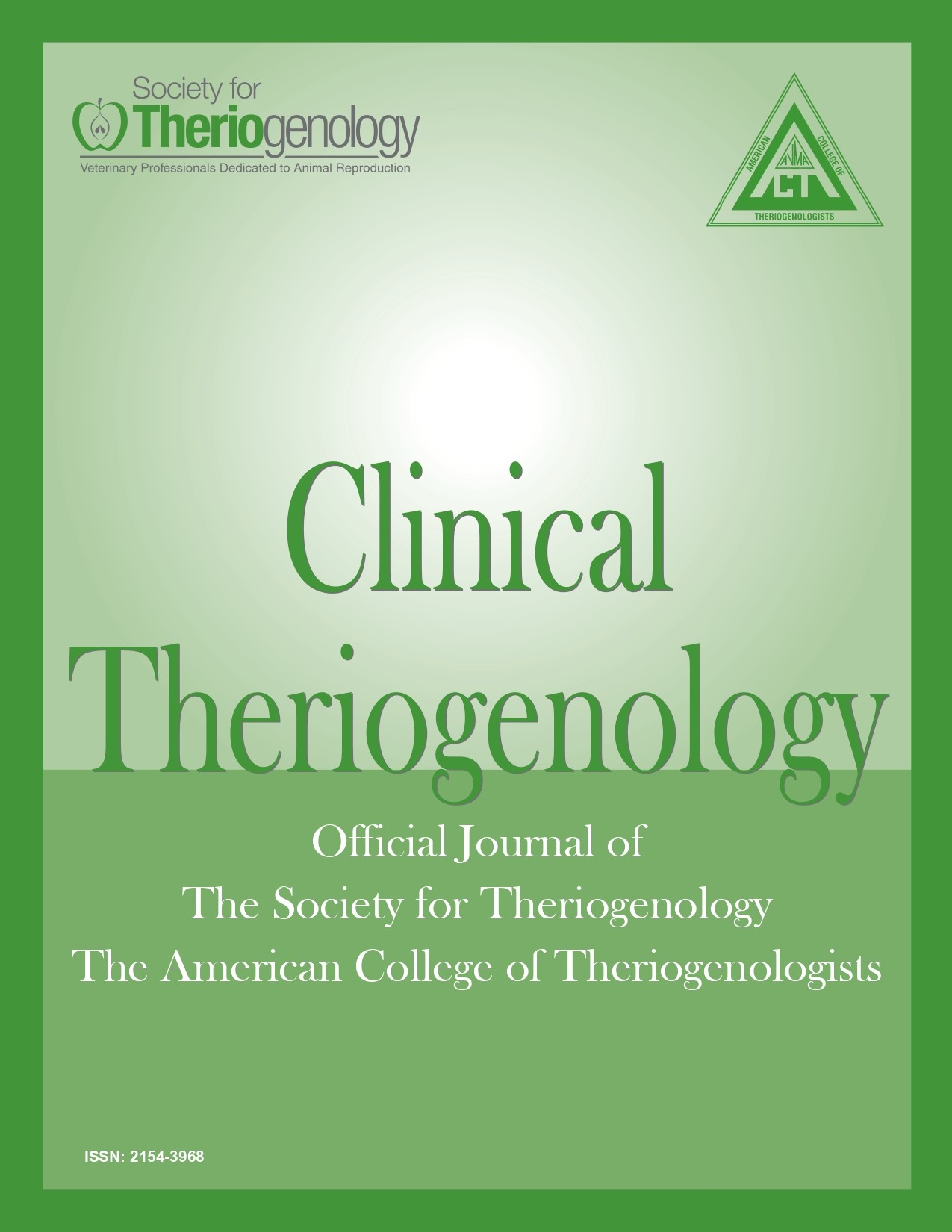Disorders of sexual development in small ruminants
Abstract
Intersex conditions, also known as disorders of sexual development (DSD), are uncommon in small ruminants. This report describes in detail, 2 cases of DSD in small ruminants, including clinical presentation, histopathological and cytogenetic analysis that led to the final diagnoses. Case 1, a mixed-breed ewe, was assessed due to a reported ram-like behavior at ~ 6 months of age. Physical examination revealed abnormal external genitalia with enlarged clitoris and bilateral inguinal gonads, histologically confirmed as testicular tissue. Karyotyping revealed sex chromosome blood chimerism (54XX, 54XY), implicating freemartinism as the cause of DSD. Case 2 was a 1-year Nigerian Dwarf cryptorchid male goat presented for castration. During surgery, bilateral ovoid gonads attached to a bicornuate uterus were identified. Histology revealed testicular tissue and uterus alongside vas deferens were consistent with persistent Müllerian duct syndrome. This report describes presentations, findings, and features of DSD, a rare occurrence in small ruminants.
Downloads
References
2. Albarella S, D’anza E, Galdiero G, et al: Cytogenetic analyses in ewes with congenital abnormalities of the genital apparatus. Animals 2019;9:1–10. doi: 10.3390/ani9100776
3. Peretti V, Ciotola F, Albarella S, et al: XX/XY chimerism in cattle: clinical and cytogenetic studies. Sex Dev 2008;2:24–30. doi: 10.1159/000117716
4. Villagómez DAF, Parma P, Radi O, et al: Classical and molecular cytogenetics of disorders of sex development in domestic animals. Cytogenet Genome Res 2009;126:110–131. doi: 10.1159/000245911
5. Eldridge FE, Blazak WF: Chromosomal analysis of fertile female heterosexual twins in cattle. J Dairy Sci 1977;60:458–463. doi: 10.3168/jds.S0022-0302(77)83888-5
6. Dain A: The incidence of freemartinism in sheep. J Reprod Fertil 1971;24:91–97. doi: 10.1530/jrf.0.0240091
7. Parkinson TJ, Smith KC, Long SE, et al: Inter-relationships among gonadotrophins, reproductive steroids and inhibin in freemartin ewes. Reproduction 2001;122:397–409. doi: 10.1530/rep.0.1220397
8. Vegter AR, Kooistra HS, Sluijs FJ van, et al: Persistent mullerian duct syndrome in a Miniature Schnauzer dog with signs of feminization and a sertoli cell tumour. Reprod Domest Anim 2010;45:447–452. doi: 10.1111/j.1439-0531.2008.01223.x
9. Brace MD, Peters O, Menzies P, et al: Sex chromosome chimerism and the freemartin syndrome in Rideau Arcott sheep. Cytogenet Genome Res 2008;120:132–139. doi: 10.1159/000118752
10. Smith KC, Parkinson TJ, Pearson GR, et al: Morphological, his tological and histochemical studies of the gonads of ovine freemartins. Vet Rec 2003;152:199–201. doi: 10.1136/vr.152.7.199
11. Kozubska-Sobocinska A, Smołucha G, Danielak-Czech B: Early diagnostics of freemartinism in polish holstein-friesian female calves. Animals 2019;9:1–11. doi: 10.3390/ani9110971
12. Shrestha JNB, Heaney DP, Parker RJ: Productivity of three synthetic Arcott sheep breeds and their crosses in terms of 8-mo breeding cycle and artificially reared lambs. Small Rumin Res 1992;9:283–296. doi: 10.1016/0921-4488(92)90157-Y
13. Esteves A, Båge R, Payan-Carreira R: Freemartinism in cattle. In: Mendes RE: editor. Ruminants: Anatomy, Behavior and Diseases. 1st edition, New York: Nova Biomedical; 2012:99–120.
14. Meyers-Wallen VN: Inherited disorders in sexual development. J Hered 1999;90:93–95. doi: 10.1093/jhered/90.1.93
15. Park EJ, Lee SH, Jo YK, et al: Coincidence of Persistent Müllerian duct syndrome and testicular tumors in dogs. BMC Vet Res 2017;13:4–9. doi: 10.1186/s12917-017-1068-6
16. Matsuu A, Hashizume T, Kanda T, et al: A case of persistent Müllerian duct syndrome with Sertoli cell tumor and hydrometra in a dog. J Vet Med Sci 2009;71:379–381. doi: 10.1292/jvms.71.379
17. Menezes Paz G De, Das N, Dorneles Coelho G, et al: Piometra associada a criptorquidismo em cão pseudo-hermafrodita masculino com síndrome da persistência dos ductos de Müller Pyometra associated to cryptorchidism in a male pseudohermaphrodite dog with persistent Müllerian duct syndrome. Rev Bras Reprod Anim 2018;4:727–731.
18. Dzimira S, Wydooghe E, Soom A Van, et al: Sertoli cell tumour and uterine leiomyoma in Miniature Schnauzer dogs with persistent Müllerian duct syndrome caused by mutation in the AMHR2 gene. J Comp Pathol 2018;161:20–24. doi: 10.1016/j.jcpa.2018.04.004
19. Pujar S, Meyers-Wallen VN: A molecular diagnostic test for persistent müllerian duct syndrome in miniature schnauzer dogs. Sex Dev 2009;3:326–328. doi: 10.1159/000273264
20. Smit MM, Ekenstedt KJ, Minor KM, et al: Prevalence of the AMHR2 mutation in Miniature Schnauzers and genetic investigation of a Belgian Malinois with persistent Müllerian duct syndrome. Reprod Domest Anim 2018;53:371–376. doi: 10.1111/rda.13116
21. Haibel GK, Rojko JL: Persistent müllerian duct syndrome in a goat. Vet Pathol 1990;27:135–137. doi: 10.1177/030098589002700214
22. Boulanger L, Pannetier M, Gall L, et al: FOXL2 is a female sex-determining gene in the goat. Curr Biol 2014;24:404–408. doi: 10.1016/j.cub.2013.12.039
23. Simon R, Lischer HEL, Pieńkowska-Schelling A, et al: New genomic features of the polled intersex syndrome variant in goats unraveled by long-read whole-genome sequencing. Anim Genet 2020;51:439–448. doi: 10.1111/age.12918

This work is licensed under a Creative Commons Attribution-NonCommercial 4.0 International License.
Authors retain copyright of their work, with first publication rights granted to Clinical Theriogenology. Read more about copyright and licensing here.





